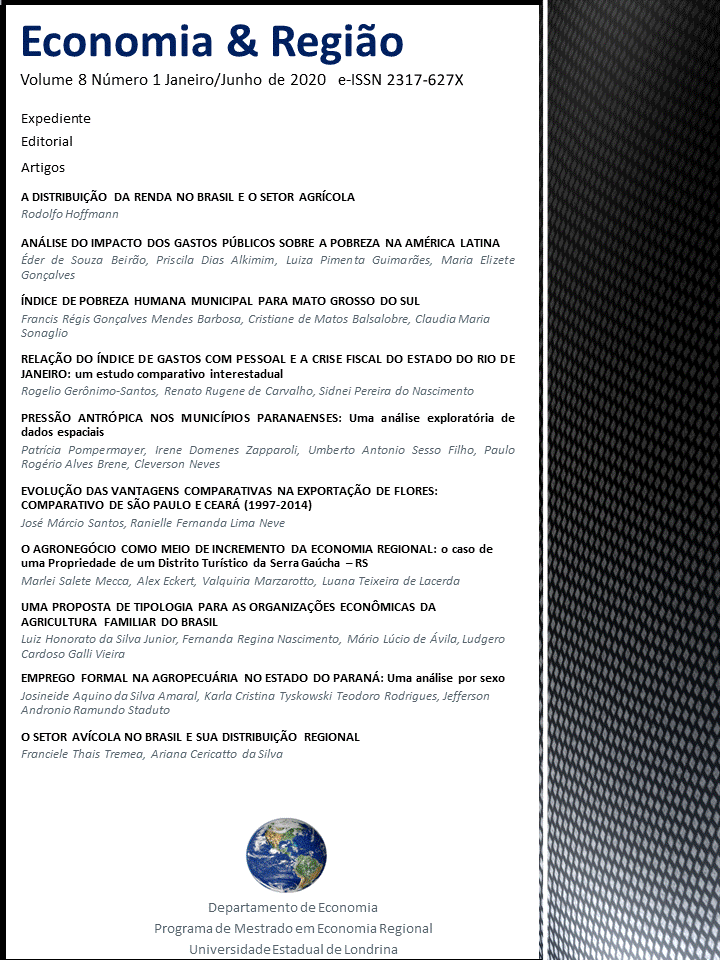The distribution of income in Brazil and agriculture sector
DOI:
https://doi.org/10.5433/2317-627X.2020v8n1p5Keywords:
Inequality, Income distribution, Gini index, Concentration ratios Brazil.Abstract
Using data from the new continuous survey of household’s sample (PNAD continua) for 2017, it is initially shown how the classification of occupied people according to their main activity as agricultural or non-agricultural is much different from their classification according to rural or urban residence. In the State of São Paulo, 62.4% of occupied people on rural area have a non-agricultural main activity. The factor component decomposition of the Gini index leads to the evaluation of the degree of progressivity of each income component. The transfers from the Bolsa-Família program are very progressive, being well focalized on the poor. When earnings are distinguished according to sector of activity, it is shown that agricultural earnings are the most progressive and that public employee’s earnings are strongly regressive.
Downloads
References
HOFFMANN, R. Decomposition of Mehran and Piesch inequality measures by factor components and their application to the distribution of per capita household income in Brazil. Brazilian Review of Econometrics, v. 24, n. 1, p. 149-171, maio 2004.
HOFFMANN, R. Distribuição da renda agrícola e sua contribuição para a desigualdade de renda no Brasil. Revista de Política Agrícola, v. 20, n. 2, p.5-22, abr./jun. 2011.
HOFFMANN, R. How to measure the progressivity of an income component. Applied Economics Letters, v. 20, n. 4, p. 328-331, 2013.
HOFFMANN, R. Distribuição da renda no Brasil em 2016: parcelas progressivas e parcelas regressivas. Casa das Garças: IEPE, 2018. Texto para Discussão n. 43
IBGE Síntese de indicadores sociais: uma análise das condições de vida da população brasileira, 2018. Rio de Janeiro: IBGE, 2018. 151 p.
JESUS, J.G.; HOFFMANN, R. Desigualdade de renda no Brasil: a contribuição de parcelas do rendimento domiciliar per capita, destacando o setor agrícola. Revista de Economia Aplicada, v. 62, n. 1, p.25-40, jan.-jun. 2015.
KAKWANI, N. Applications of Lorenz curves in economic analysis. Econometrica, v. 45, n. 3, p. 719-728, abr. 1977.
NICHOLSON, B. A previdência injusta: como o fim dos privilégios pode mudar o Brasil. São Paulo, Geração Editorial, 2007.
PYATT, G.; CHEN, C.N.; FEI, J. (1980) The distribution of income by factor components. The Quarterly Journal of Economics, v. 95, n. 3, p. 451-473, nov. 1980.
RAO, V.M. Two decompositions of concentration ratio. Journal of the Royal Statistical Society, series A (general), v. 132, n. 3, p. 418-425, 1969.
YITZHAKI, S.; SCHECHTMAN, E. The Gini methodology: a primer on a statistical methodology. Springer & Business Media, 2012
Downloads
Published
How to Cite
Issue
Section
License
Economia & Região adota a Licença Creative Commons Attribution CC-BY 4.0 International, portanto, os direitos autorais relativos aos artigos publicados são do(s) autor(es), que cedem à Revista Economia & Região o direito de exclusividade de primeira publicação.
Sob essa licença é possível: Compartilhar - copiar e redistribuir o material em qualquer suporte ou formato. Adaptar - remixar, transformar, e criar a partir do material, atribuindo o devido crédito e prover um link para a licença e indicar se mudanças foram feitas.














